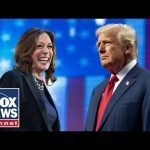In the ever-shifting landscape of American politics, economics is often the battleground where ideologies clash. Recent polling suggests that a staggering 59% of Americans believe the economy is getting worse. This isn’t just a minor blip on the radar; it’s a wake-up call for leaders like Kamala Harris, who are facing an uphill battle as the election looms ever closer. On one side stands former President Donald Trump, armed with a blend of economic strategies that ferries across the spectrum from populism to free-market policies, and on the other, Harris, whose planned tax hikes and regulation increases might just take the wind out of the sails of small businesses nationwide.
Trump’s economic approach can only be described as a cauldron of ideas, mixing elements reminiscent of historical figures like Ross Perot—who vehemently opposed free trade agreements—and Ronald Reagan, a staunch supporter of them. This unconventional blend seems to resonate with both ends of the spectrum—drawing admirers and earning critics in equal measure. The former President’s recent remarks implying an escalation in trade tariffs, particularly on China, certainly stirred the pot. By suggesting that the U.S. might impose heavier tariffs on Chinese imports, he puts forth a bold stance on trade reciprocity that could streamline numerous negotiations on the global stage.
Yet, with boldness comes risk. The tit-for-tat trade war echoes the detrimental Smoot-Hawley Tariff Act of the 1930s, which many analysts believe worsened the Great Depression. The stakes are high as America’s leadership must find a sweet spot that protects domestic industries without triggering a trade standoff. But overlooking the fine details could lead to unintended consequences, as the business community, comprised of both large corporations and small enterprises, watches anxiously. For business owners, the abstract world of tariffs doesn’t just float above their heads; it weighs heavily on their bottom line.
In stark contrast to Trump’s model, Harris’s economic plans are structured around raising corporate tax rates to stratospheric levels and exerting stricter regulations on businesses. While intended as a means to distribute wealth more equitably, many in the small business sector are walking a tightrope, worried that they won’t be able to keep up with the compliance burden. Unlike corporations that have entire legal and finance teams to navigate these complexities, small businesses face a triple threat—limited resources, a cumbersome regulatory environment, and an uphill battle to survive in a competitive market.
Beyond the tax implications, the philosophical divide between the two candidates is glaring. Trump advocates for incentivizing entrepreneurship and fostering a thriving free market, while Harris leans into what many perceive as handouts. The latter’s approach may bring immediate relief to individuals, but it begs the question: are these short-term band-aids enough to stimulate long-lasting economic growth? As Trump circles back to negotiations, armed with a clearer vision of thriving industries and job creation, the small businesses that line the streets of America await with bated breath.
The unraveling economic story will unfold as the election approaches. Will Trump’s aggressive trade tactics cultivate a robust economy full of opportunity? Or will Harris’s redistribution agenda pave the way for a more equitable—but potentially stunted—economic landscape? As pundits erupt with opinions and concerns, one thing remains clear: the stakes couldn’t be higher for the American people. In true American spirit, they are left to speculate, discuss, and dissect every twist and turn, hoping for a leader who will steer the nation toward prosperity.




